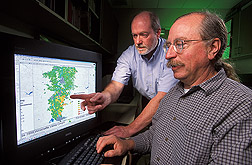This page has been archived and is being provided for reference purposes only. The page is no longer being updated, and therefore, links on the page may be invalid.
Read the magazine story to find out more. |
|
|
High-Tech Tools Tackle Ag Management
By Laura McGinnisJuly 26, 2007
New, high-tech tools developed by Agricultural Research Service (ARS) scientists are helping farmers and managers make better-informed decisions by assessing the economic and ecological outcomes of different management practices. ARS is the U.S. Department of Agriculture's chief scientific research agency.
Profitable environmental management relies on a variety of factors, and balancing economic and ecological interests can be challenging. To assist managers in this task, Jason Bergtold, an economist at the ARS National Soil Dynamics Laboratory, Auburn, Ala., is working with colleagues to develop two user-friendly tools--an economic model and a farm payment calculator. The Conservation Systems Learning Tool model predicts how profitable various crops will be under different management systems. The Crop Profitability Calculator evaluates how factors such as conservation incentive payments and practices influence the profitability of crop enterprises.
Bergtold's research also investigates whether conservation practices are being accepted, maintained or intensified, and why. For example, he and his colleagues have nearly completed a study that examines how factors such as demographics, farm characteristics, management practices and personal beliefs influence southeastern farmers who could qualify for economic support by adopting conservation practices.
Understanding the incentives that lead farmers to embrace conservation could help program developers, researchers and policymakers transfer conservation technology more successfully.
Jerry Whittaker, a hydrologist in the ARS Forage, Seed and Cereal Research Unit, Corvallis, Ore., is helping to develop a two-model system to evaluate conservation practices. First, an economic model chooses different management decisions, such as the amount of chemicals to apply. Then that information is fed into the second model to evaluate the environmental effects of different economic decisions.
Whittaker is also speeding up economic analysis with a massive, custom-made parallel computer called a "Beowulf cluster." This is a very large, very fast, problem-solving computer--or rather, a cluster of inexpensive computers linked via Ethernet.
Technology like this enables faster analysis of various conservation practices' effects. This, in turn, enables managers to quickly decide whether to keep up, step up, or switch up their efforts for maximum benefit.
Read more about the research in the July 2007 issue of Agricultural Research magazine.

